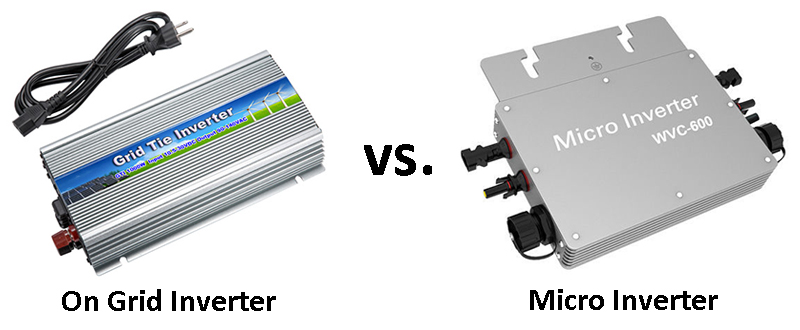Solar inverter is the core power conditioning device of photovoltaic system, which accounts for 10-15% of system cost, and has high technical content. Solar inverter converts the direct current generated by solar cells into alternating current energy that can be directly integrated into the grid and load through power electronic conversion technology. However, what is the difference between a grid tied inverter and a micro inverter?

Grid tied inverter
The on grid inverter is a special kind of inverter. In addition to converting direct current into alternating current, the output alternating current can be synchronized with the frequency and phase of the mains, so the output alternating current can return to the mains. Grid tied inverters are commonly used in applications where some DC voltage sources (such as solar panels or small wind turbines) are connected to the grid.
How it Work?
In an on-grid system, multiple solar panels are wired together in series to form a string. The DC electricity generated by these panels is sent to a single central inverter. This solar inverter converts the combined DC output into AC, which can be used immediately by the household or fed into the grid.
Advantages:
- Adopts modular structure. It can improve system efficiency and power quality to a certain extent, and has high reliability of parallel redundancy, convenient installation and maintenance, and saves land occupation.
- Reliability. When one or more modules fail, the system can continue to provide power to the grid, with high availability; multiple redundant modules can be selected to improve system reliability.
- Maintainability. It is easy to maintain, and module replacement time is less than 10 minutes, no professional technicians are required.
- Cost-Effective. On grid tie inverters tend to be less expensive upfront compared to microinverters. The cost per watt of electricity produced is generally lower because a single inverter handles multiple panels.
- Simplicity. Installation and maintenance are simpler with fewer components involved. This can result in lower installation costs and easier troubleshooting.
Applications:
- Utility-Scale Solar Power Plants. On-grid inverters serve as the backbone of utility-scale solar power plants, where vast arrays of solar panels generate electricity for the grid. These inverters are designed for high power outputs and optimal efficiency to maximize the energy yield of solar installations. On-grid inverters ensure grid stability by regulating the flow of electricity and adhering to grid codes and standards.
- Wind Energy Systems. On-grid inverters are also used in wind power systems to convert the variable AC output from wind turbines into a stable AC current suitable for grid use.
Micro inverter
A solar micro inverter is a device that converts direct current from a single solar cell module to alternating current. The DC power conversion of the micro-inverter is AC from a single solar module, each solar cell module is equipped with inverter and converter functions, and each module can perform current conversion independently. Micro inverters can achieve maximum power point tracking (MPPT) at the panel level, which has advantages over central inverters. In this way, the output power of each module can be optimized to maximize the overall output power.
How it Work?
Microinverters are attached directly to individual solar panels, converting DC to AC right at the source. This means each panel operates independently, and the AC electricity from each microinverter is combined and fed into the household electrical system or the grid.
Advantages:
- Enhanced Performance. Because each panel operates independently, shading or damage to one panel does not affect the performance of the others. This maximizes the overall energy production of the system.
- Increased Reliability. With multiple inverters, the failure of one microinverter does not take down the entire system, allowing the remaining panels to continue generating power.
- Granular Monitoring. Microinverters provide detailed performance data for each panel, making it easier to identify and address issues, optimizing maintenance and performance.
- Flexible Design. Systems with microinverters can be easily expanded by adding more panels without the need for a larger central inverter.
Applications:
- Residential Solar Installations. Solar power micro inverters are widely used in home solar power systems. They optimize the energy output of each individual solar panel, making them ideal for rooftops with shading issues or varying panel orientations.
- Commercial Solar Projects. In commercial buildings, solar cell micro inverters are utilized to ensure maximum efficiency and reliability. They allow for scalable and modular installations, facilitating easy expansion and maintenance.
- Agricultural Solar Systems. Farms and agricultural facilities benefit from micro inverters for powering irrigation systems, lighting, and other equipment. They are particularly useful in remote areas where consistent power generation is critical.
